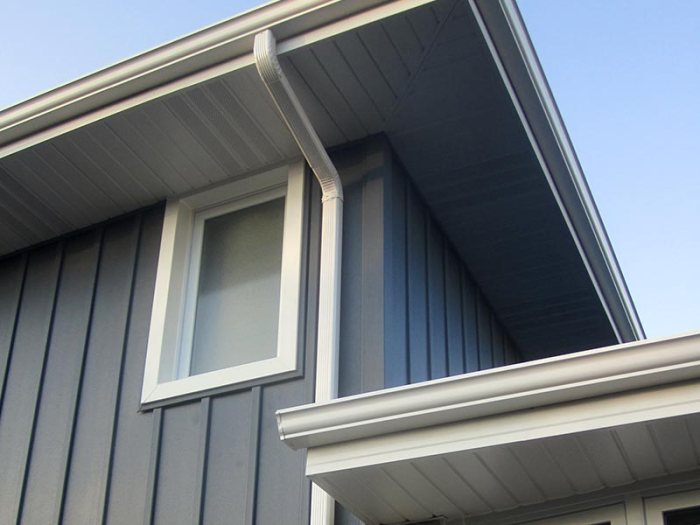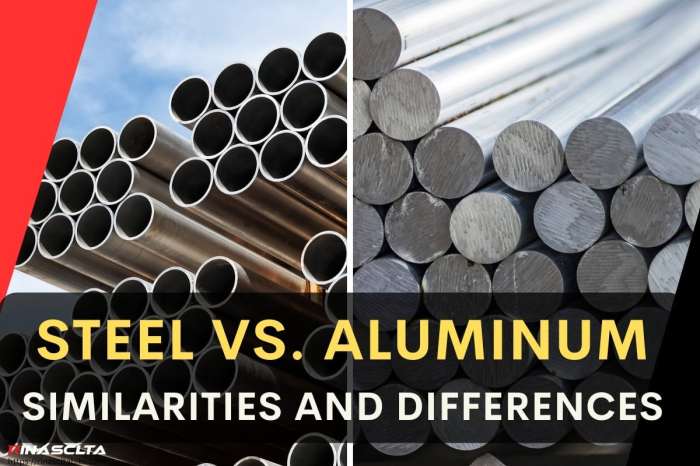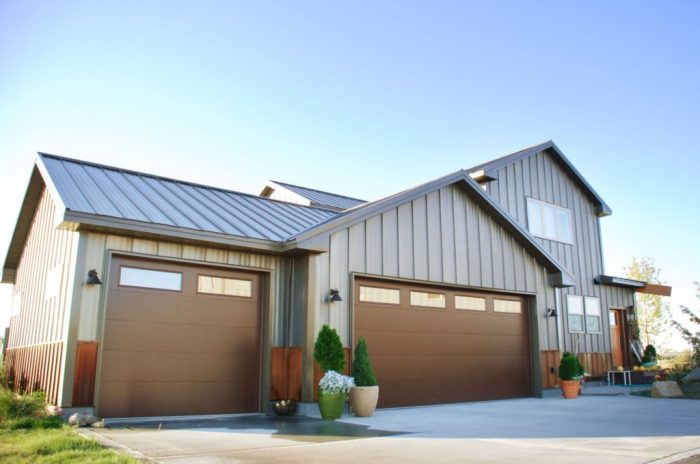Steel Siding vs Aluminum Siding A Homeowners Guide

Steel siding vs aluminum siding: Choosing the right exterior cladding for your home can feel overwhelming. Both materials offer durability and a range of aesthetic options, but understanding their differences in cost, lifespan, maintenance, and environmental impact is crucial for making an informed decision. This guide breaks down the key factors to consider, helping you weigh the pros and cons of each to find the perfect fit for your project and budget.
We’ll delve into a detailed comparison, examining everything from initial investment and long-term costs to the aesthetic appeal and environmental considerations. We’ll also explore the practical aspects of installation, maintenance, and repair, providing you with the knowledge to confidently choose the best siding for your home.
Cost Comparison

Source: aluminum.com
Choosing between steel and aluminum siding involves carefully considering upfront costs and long-term expenses. While aluminum might seem cheaper initially, the total cost of ownership over the lifespan of your siding can vary significantly. Let’s break down the pricing and maintenance aspects to help you make an informed decision.
The average cost of siding installation includes material costs and labor. Labor costs are influenced by factors like the complexity of your home’s exterior, accessibility, and regional labor rates. Material costs, however, are relatively consistent across regions for a given material type.
Material and Installation Costs
Generally, aluminum siding is less expensive upfront than steel siding. You can expect to pay anywhere from $2 to $8 per square foot for aluminum siding, including installation, while steel siding typically ranges from $4 to $12 per square foot, again including installation. The wider ranges reflect variations in quality, features (like thickness and color), and regional pricing differences. Higher-end options, such as those with enhanced durability or aesthetic features, will naturally command higher prices.
Long-Term Cost Implications
While the initial cost difference might seem significant, the long-term maintenance and potential repair costs need to be factored in. Steel siding, due to its greater strength and resistance to dents and damage, often requires less maintenance and fewer repairs over its lifetime. Aluminum siding, while lighter and easier to handle during installation, is more susceptible to denting and scratching. This can lead to increased repair costs over time, especially if you live in an area prone to hail or severe weather.
Cost Comparison Table
This table provides a simplified comparison, using average figures. Actual costs can vary significantly based on factors mentioned earlier. The figures represent a hypothetical 1,000 square foot house.
| Material | Initial Cost (1000 sq ft) | Maintenance Cost (10 years) | Total Cost of Ownership (10 years) |
|---|---|---|---|
| Aluminum | $4,000 – $8,000 | $1,000 – $2,000 | $5,000 – $10,000 |
| Steel | $6,000 – $12,000 | $500 – $1,000 | $6,500 – $13,000 |
Note: These are estimates. Actual costs may vary depending on the specific products chosen, contractor rates, and the condition of your home. It’s always recommended to obtain multiple quotes from reputable contractors before making a decision.
Durability and Longevity

Source: alumtechbond.com
Choosing between steel and aluminum siding involves considering their respective strengths and weaknesses in terms of how well they stand up to the test of time and the elements. Both materials offer decent durability, but their performance varies depending on factors like climate and the quality of installation.
Steel and aluminum siding both resist damage to varying degrees. However, their responses to impacts, dents, and scratches differ significantly. Understanding these differences is crucial for making an informed decision.
Impact, Dent, and Scratch Resistance
Steel siding, due to its inherent strength, generally offers superior resistance to impacts compared to aluminum. A strong blow might dent aluminum siding more readily, leaving a noticeable mark. Steel, while not indestructible, tends to withstand impacts better, minimizing visible damage. Scratches are also more easily visible on aluminum’s smoother surface, while steel’s texture can sometimes mask minor abrasions. However, both materials can be scratched or dented with sufficient force; the difference lies in the level of force required and the visibility of the resulting damage. Think of it like this: a dropped hammer might leave a significant dent in aluminum, while the same hammer might only cause a minor imperfection on steel.
Lifespan Under Various Climatic Conditions
The lifespan of both steel and aluminum siding is significantly influenced by climate. Extreme heat can cause expansion and contraction, potentially leading to warping or cracking, particularly in poorly installed siding. Heavy snow loads can also put stress on the siding system, potentially causing damage. In regions with extreme temperature fluctuations or harsh winters, careful consideration of material choice and installation techniques is essential. Coastal areas, with their salty air, present another challenge, as both steel and aluminum can be susceptible to corrosion. Proper coatings and maintenance are crucial in such environments to extend the lifespan of either material. For example, a home in Arizona might experience accelerated deterioration of both materials due to intense heat, while a home in Alaska might face challenges from heavy snowfall and freezing temperatures.
Typical Lifespan and Maintenance Needs
Let’s look at the typical lifespan and maintenance requirements for each type of siding:
- Steel Siding: With proper installation and maintenance, steel siding can last 30-50 years or even longer. Regular cleaning to remove dirt and debris, and occasional repainting to maintain the protective coating, are essential for maximizing its lifespan. Addressing any signs of rust or corrosion promptly is also crucial.
- Aluminum Siding: Aluminum siding typically lasts 20-40 years. While it’s naturally resistant to rust, it can be susceptible to denting and scratching. Regular cleaning and occasional repairs to address any damage are recommended to maintain its appearance and structural integrity. In coastal regions, additional attention to potential corrosion is needed.
Appearance and Aesthetics

Source: rinascltabike.com
Choosing between steel and aluminum siding often comes down to personal preference, but understanding the aesthetic differences can significantly impact your home’s curb appeal. Both materials offer a wide range of color and finish options, but they achieve different visual effects. Steel siding, with its potentially richer color saturation and heavier feel, can project a more substantial and modern look, while aluminum siding, often lighter in weight and appearance, might lend itself to a more contemporary or even rustic feel depending on the chosen finish.
Steel and aluminum siding offer distinct aesthetic qualities that cater to various architectural styles and homeowner preferences. The visual impact depends heavily on the chosen color, texture, and overall design.
Color Options and Texture Variations
Both steel and aluminum siding boast a vast array of color choices, from classic earth tones to bold, contemporary shades. However, the way these colors appear can differ slightly. Steel siding, due to its thicker coating, often exhibits richer, more vibrant colors. Aluminum, while offering a wide palette, might appear slightly less saturated. Texture is another key differentiator. Steel siding can achieve a more pronounced texture, with options ranging from smooth to deeply embossed wood grain or stone patterns. Aluminum siding also offers textured options, but these may be less dramatic. For instance, a steel siding mimicking cedar shake will have a more realistic three-dimensional appearance compared to an aluminum equivalent. The subtle differences in texture can significantly influence the perceived weight and overall visual impact of the siding.
Architectural Style Suitability
Steel siding’s durability and ability to mimic other materials make it a suitable choice for a variety of architectural styles. Its strength allows for bolder, more modern designs with sharp lines and geometric patterns. A sleek, dark gray steel siding would complement a contemporary home perfectly. Conversely, steel siding can also effectively mimic the look of traditional materials like wood or stone, making it appropriate for more rustic or craftsman-style homes. The heavier, more substantial appearance of steel siding can lend a sense of permanence and strength to the overall design.
Aluminum siding, with its lighter weight and ability to be formed into various profiles, is well-suited for homes with more delicate architectural details. Its versatility allows it to complement styles ranging from ranch-style homes to Cape Cods. A lighter colored aluminum siding with a subtle texture might enhance the charm of a classic New England-style home. The lighter weight of aluminum also makes it a practical choice for homes in areas prone to high winds, as it places less stress on the structure.
Visual Impact of Different Finishes, Steel siding vs aluminum siding
Smooth finishes on both steel and aluminum siding offer a clean, contemporary look. They are easy to maintain and create a minimalist aesthetic. However, textured finishes provide a more visually interesting surface. Steel siding with a wood-grain finish can create a realistic, rustic look that might be preferred by those who desire the aesthetic of wood siding without the maintenance. Similarly, aluminum siding with a stone-like texture can offer a visually appealing alternative to actual stone, creating a more dramatic and textured facade. The depth and realism of these textured finishes are often more pronounced in steel siding due to its ability to support more complex embossing. A smooth finish might be best for a modern home, while textured finishes work well in more traditional or rustic settings.
Maintenance and Repair: Steel Siding Vs Aluminum Siding
Choosing between steel and aluminum siding involves considering long-term maintenance needs. Both materials are relatively low-maintenance, but understanding their specific requirements will help you make an informed decision and plan for potential costs. This section details cleaning, common problems, and repair methods for each type of siding.
Steel Siding Maintenance and Repair
Steel siding is known for its durability, but it still requires periodic cleaning and occasional repairs. Regular cleaning prevents the buildup of dirt, grime, and mildew, which can lead to corrosion and damage. For cleaning, a simple solution of mild detergent and water, applied with a soft-bristled brush or sponge, is usually sufficient. Power washing should be avoided as it can damage the siding’s protective coating.
Common problems with steel siding include scratches, dents, and rust. Scratches are usually cosmetic and may not require repair, but deep scratches should be touched up with paint to prevent rust. Dents can often be repaired by carefully pushing them back into place from behind, but significant dents might require professional panel replacement. Rust, typically occurring around damaged areas or in areas with poor drainage, necessitates immediate attention. Rust spots should be cleaned, treated with a rust converter, and then repainted. Larger areas of rust may require panel replacement.
Aluminum Siding Maintenance and Repair
Aluminum siding is highly resistant to rust and corrosion, making it a very low-maintenance option. Regular cleaning with a mild detergent and water solution, applied with a soft brush or sponge, is typically all that’s needed to keep it looking its best. Power washing is generally acceptable for aluminum, but avoid high pressure to prevent damage.
Common issues with aluminum siding include dents and scratches. Dents, similar to steel siding, can sometimes be pushed back into place from the rear. However, significant dents may require replacement of the affected panel. Scratches are usually superficial and primarily cosmetic, often requiring only a touch-up of paint. Aluminum siding rarely experiences significant damage beyond dents and scratches due to its inherent flexibility and corrosion resistance.
Maintenance and Repair Comparison
The following table summarizes the maintenance and repair aspects of steel and aluminum siding:
| Feature | Steel Siding | Aluminum Siding |
|---|---|---|
| Cleaning Frequency | Annually, or as needed | Annually, or as needed |
| Typical Repair Costs (per panel) | $50 – $200+ (depending on damage) | $30 – $150+ (depending on damage) |
| Ease of Repair | Moderate; some repairs require specialized tools or professional assistance. | Easy; many minor repairs can be done by a homeowner |
Environmental Impact
Choosing between steel and aluminum siding involves considering their respective environmental footprints. Both materials have impacts throughout their lifecycles, from raw material extraction and manufacturing to transportation, installation, and eventual disposal or recycling. Understanding these impacts is crucial for making an informed decision that aligns with environmental responsibility.
Steel and aluminum siding differ significantly in their environmental impact profiles. The production of both materials is energy-intensive, but the type of energy used and the overall energy consumption vary. Transportation distances also influence the carbon footprint, as do the recycling rates and end-of-life management strategies for each material.
Manufacturing Processes and Energy Consumption
Steel production is a highly energy-intensive process, often relying on fossil fuels like coal and natural gas in blast furnaces to reduce iron ore. This process releases significant amounts of greenhouse gases, primarily carbon dioxide. Aluminum production, while also energy-intensive, typically utilizes electricity through the Hall-Héroult process. The environmental impact depends heavily on the source of electricity; hydropower-based aluminum production has a lower carbon footprint compared to production reliant on fossil fuel-generated electricity. The overall energy intensity of steel production generally leads to a larger carbon footprint during the manufacturing stage than aluminum production, assuming a similar electricity mix.
Transportation and Distribution
The transportation of both steel and aluminum siding contributes to greenhouse gas emissions. The distance between manufacturing facilities and construction sites significantly influences the environmental impact. Heavier steel siding generally requires more fuel for transportation compared to lighter aluminum siding, assuming equal quantities. However, efficient logistics and transportation methods can mitigate this impact for both materials. Consideration should be given to the origin of the materials and the overall transportation distance when evaluating environmental impact.
Recyclability and Sustainability
Both steel and aluminum are highly recyclable materials. Steel can be recycled indefinitely without loss of properties, making it a highly sustainable option. Aluminum is also highly recyclable, with a relatively low energy requirement for reprocessing compared to primary aluminum production. The recycling rates for each material vary by region and depend on efficient collection and processing infrastructure. High recycling rates significantly reduce the overall environmental impact by reducing the need for new material production. The availability of recycling programs and the ease of recycling should be considered.
Carbon Footprint Comparison
A comprehensive life cycle assessment (LCA) is necessary to accurately compare the total carbon footprint of steel and aluminum siding. Such assessments consider all stages of the product lifecycle, from raw material extraction to disposal or recycling. While definitive numbers vary based on factors like manufacturing processes, energy sources, transportation distances, and recycling rates, studies generally indicate that the carbon footprint of steel siding tends to be higher than that of aluminum siding, particularly when considering the energy intensity of steel production. However, aluminum’s energy-intensive production process means that the choice is not straightforward. The carbon footprint is highly dependent on the specific circumstances and regional factors.
Insulation and Energy Efficiency
Steel and aluminum siding, while offering distinct advantages in durability and aesthetics, differ significantly in their inherent insulation properties. Understanding these differences is crucial for homeowners aiming to minimize energy consumption and lower their utility bills. Neither material provides significant insulation on its own; their impact on energy efficiency is primarily related to how well they contribute to a home’s overall thermal envelope.
Aluminum siding, being a highly conductive metal, transfers heat more readily than steel. This means that in hot climates, heat can transfer more easily into the house, increasing cooling costs. Conversely, in cold climates, heat escapes more readily, leading to higher heating costs. Steel siding, while still a conductor, offers slightly better insulation properties due to its higher density and thermal mass. This translates to a marginally better ability to resist heat transfer compared to aluminum.
Steel Siding Insulation Performance
Steel siding’s contribution to energy efficiency largely depends on the insulation installed beneath it. Properly installed insulation, such as fiberglass batts or spray foam, creates an effective barrier against heat transfer. The steel siding itself acts as a protective outer layer, shielding the insulation from the elements and maintaining its effectiveness. A well-insulated home with steel siding can significantly reduce energy consumption, especially when combined with energy-efficient windows and doors. For example, a typical 2,000 square foot home in a moderate climate could see a reduction in heating and cooling costs of 15-25% with proper insulation and steel siding compared to a poorly insulated home with similar siding.
Aluminum Siding Insulation Performance
Similar to steel siding, aluminum siding’s impact on energy efficiency is heavily reliant on the underlying insulation. However, due to aluminum’s higher thermal conductivity, achieving the same level of energy savings requires even more robust insulation. This might involve thicker insulation batts, or the use of more expensive high-performance insulation materials like closed-cell spray foam. The increased cost of insulation can offset some of the initial cost savings associated with choosing aluminum siding. In a cold climate, a home with aluminum siding might require significantly more insulation than a similar home with steel siding to achieve comparable energy efficiency. For instance, a home in a northern climate might need an additional 2-3 inches of insulation to compensate for aluminum’s increased heat transfer.
Insulation Methods with Steel and Aluminum Siding
Several insulation methods can be effectively used with both steel and aluminum siding. These include:
- Fiberglass batts: A cost-effective and widely used option, easily installed within wall cavities.
- Spray foam insulation: Offers superior air sealing and insulation properties, but is more expensive to install.
- Rigid foam insulation: Provides excellent insulation and can be used as a sheathing under the siding.
The choice of insulation method will depend on factors such as budget, climate, and existing wall construction. It’s crucial to consult with a qualified insulation contractor to determine the most appropriate method for a specific home. Proper installation is critical to ensure the insulation’s effectiveness. Air leaks around windows, doors, and other penetrations can significantly reduce the overall energy efficiency of the home, regardless of the siding material or insulation type.
Potential Energy Savings
The potential energy savings associated with either steel or aluminum siding are highly dependent on several factors, including:
- Climate: Homes in colder or hotter climates will see greater energy savings from improved insulation.
- Home size: Larger homes require more energy to heat and cool, resulting in potentially larger savings.
- Insulation type and installation: The quality and installation of the underlying insulation are critical.
- Other energy-efficient features: Energy-efficient windows, doors, and appliances contribute to overall savings.
While steel siding might offer a slight edge in terms of inherent thermal properties, the overall energy efficiency of a home depends far more on the quality and installation of the underlying insulation. A well-insulated home with either steel or aluminum siding can achieve significant energy savings, but careful consideration of these factors is essential for maximizing the return on investment.
Fire Resistance
Choosing siding for your home involves considering many factors, and fire resistance is a crucial aspect of overall safety. Both steel and aluminum siding offer varying degrees of protection against fire, but understanding their differences is key to making an informed decision. This section will compare the fire resistance properties of these materials and discuss their implications for home safety.
Steel siding generally possesses superior fire resistance compared to aluminum siding. This difference stems from the materials’ inherent properties and how they react to high temperatures.
Steel Siding Fire Resistance
Steel’s high melting point and its ability to withstand intense heat for extended periods contribute to its superior fire resistance. In a fire situation, steel siding will not readily ignite or contribute to the spread of flames. While the steel itself may eventually deform under extreme heat, it’s less likely to rapidly combust and release flammable gases compared to other materials. This makes steel siding a valuable component in fire-resistant building construction. Independent testing and building codes often reflect this higher fire resistance rating. For instance, steel siding might achieve a higher Class A fire rating in certain building codes, signifying its superior performance in fire tests.
Aluminum Siding Fire Resistance
Aluminum, while non-combustible, has a lower melting point than steel. This means that under intense heat, aluminum siding can melt and deform more quickly than steel. Although it won’t ignite like wood or vinyl siding, the melting and potential sagging of aluminum siding could compromise the structural integrity of the building’s exterior during a fire. This could allow for greater penetration of flames and potentially faster spread. Aluminum siding’s fire resistance is typically categorized as non-combustible, but its behavior under extreme heat is different from that of steel.
Safety Implications of Steel and Aluminum Siding in Fire Hazards
The differences in fire resistance between steel and aluminum siding directly impact home safety. Steel siding offers a greater level of protection, delaying the spread of fire and potentially buying valuable time for evacuation and firefighting efforts. Aluminum siding, while non-combustible, offers less protection against intense heat and may deform, potentially compromising the building’s envelope. The choice between these materials should consider the local fire risk and the overall safety priorities of the homeowner. For areas with high fire risk, steel siding might be the more prudent choice.
Fire Resistance and Home Safety
Fire resistance in siding is just one component of overall home safety, but it’s a significant one. A fire-resistant exterior helps to contain a fire, slowing its spread and minimizing damage. This increased time allows occupants to safely evacuate and reduces the risk of the fire spreading to neighboring structures. The material’s performance during a fire can significantly impact the extent of damage and the overall outcome of a fire event. Consideration of fire resistance, alongside other safety features, contributes to a safer and more secure living environment.
Weight and Installation
Steel and aluminum siding differ significantly in weight, impacting installation complexity and the overall project cost. Aluminum is considerably lighter, making it easier to handle and install, especially on larger projects. Steel, while offering superior strength, presents greater challenges due to its weight. This section will detail the installation processes for both materials and discuss potential installation challenges based on building structure.
Steel siding, being heavier, requires more robust support structures and more physically demanding installation. This can translate to higher labor costs. Aluminum, on the other hand, is more manageable, potentially reducing installation time and expenses.
Steel Siding Installation
Steel siding installation generally involves a system of interlocking panels. First, a solid sheathing is typically required, often OSB or plywood, providing a smooth, even surface for the siding. Furring strips may be needed to create a ventilation gap behind the siding. The panels are then attached to the sheathing using nails or screws, ensuring proper overlap and alignment. Specialized tools, such as panel cutters and rivet guns, might be necessary. Working with heavier steel panels requires more attention to safety and proper lifting techniques to avoid injury. The weight can also impact the efficiency of the installation process. For example, installing steel siding on a two-story house might require more time and workers compared to aluminum.
Aluminum Siding Installation
Aluminum siding installation shares similarities with steel, but its lighter weight simplifies many aspects. While a solid sheathing is still recommended, the lighter panels are easier to handle and maneuver, leading to potentially faster installation. The interlocking design remains similar, but the reduced weight minimizes strain on installers and reduces the risk of damage during handling. The lighter weight can be particularly beneficial on complex building structures or in situations with limited access. For instance, installing aluminum siding on a multi-faceted Victorian-style home might prove significantly less challenging than using steel.
Installation Challenges Based on Building Structure
The weight difference between steel and aluminum siding significantly impacts installation on various building structures. On simple, single-story buildings with easy access, the weight difference might be less noticeable. However, on complex structures like multi-story buildings, buildings with irregular shapes, or those with limited access points, the lighter weight of aluminum becomes a significant advantage. The reduced weight minimizes the risk of damage during transport and handling, and it makes the installation process safer and more efficient. Steel siding’s weight can present challenges in reaching high points on the structure, requiring specialized equipment and more skilled labor. Furthermore, the increased weight can put extra stress on existing building structures, particularly older ones.
Closing Summary

Source: sidingauthority.com
Ultimately, the “best” siding – steel or aluminum – depends on your priorities and circumstances. Consider your budget, desired aesthetic, climate, and long-term maintenance preferences. By carefully weighing the factors discussed – cost, durability, appearance, maintenance, environmental impact, energy efficiency, fire resistance, and installation – you can make a confident choice that enhances your home’s value and curb appeal for years to come. Remember to get multiple quotes from reputable contractors to ensure a smooth and successful installation process.
FAQ Resource
Can I paint steel and aluminum siding?
Yes, both can be painted, but aluminum is generally easier to paint and requires less preparation. Steel siding might require more surface preparation to ensure proper adhesion.
How do I clean steel and aluminum siding?
Regular cleaning with a garden hose and mild detergent is sufficient for both. For tougher stains, use a pressure washer (low pressure for aluminum) and a suitable cleaning solution.
Which siding is better for coastal areas?
Aluminum siding’s superior corrosion resistance makes it a better choice for coastal areas prone to salt spray and humidity.
What about hail damage?
Steel siding generally offers better resistance to hail damage than aluminum, though both can be damaged by extremely large hail.
Is one material more prone to dents?
Aluminum is more susceptible to denting than steel, which is significantly stronger and more impact-resistant.
Comments are closed.